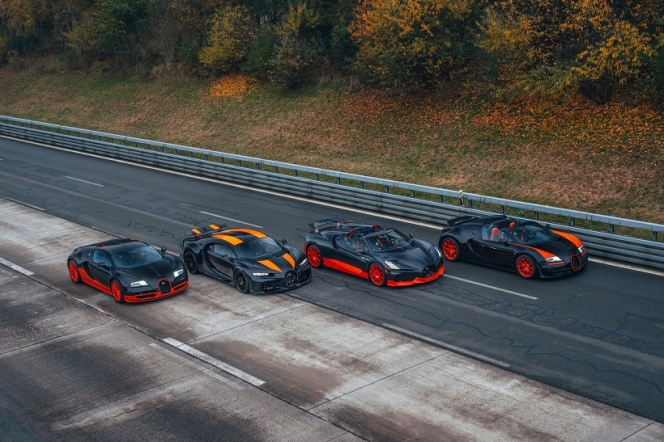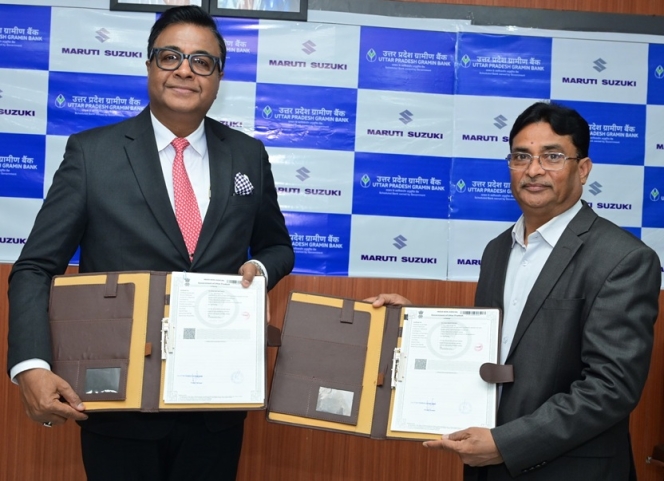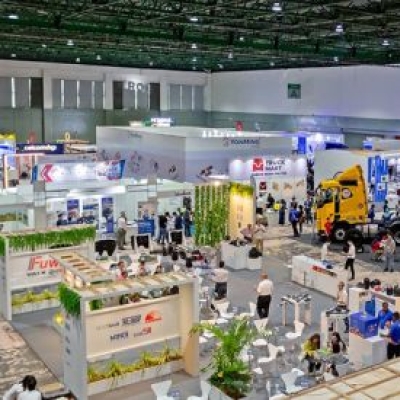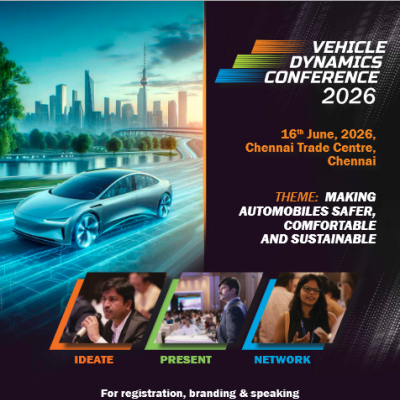- Bugatti
- Veyron 16.4 Super Sport World Record Edition
- Veyron 16.4 Grand Sport Vitesse World Record Edition
- Chiron Super Sport 300+
- W16 Mistral
Four Bugattis Represent Pure Automotive Innovation
- By Bhushan Mhapralkar
- January 16, 2025

There are four Bugatti sports cars that represent automotive innovation like no others cars do.
It would come as a surprise that the four cars that represent innovation in automobiles in its purest form are all Bugatti sports cars. Showcasing the evolution of automobiles in a way that is unique and amounts to flexing the boundaries of what machines can really be or do what they are expected to do to the fullest, the four Bugatti cars are the Veyron 16.4 Super Sport World Record Edition, Veyron 16.4 Grand Sport Vitesse World Record Edition, Chiron Super Sport 300+ and the W16 Mistral World Record Car.
Successful in carving out a niche, each of the four cars – ultra super cars – have come to represent Bugatti’s incomparable legacy. The Veyron 16.4 Super Sport World Record Edition, on a beautiful day of April 2010, achieved a new land speed world record for production cars on the proving grounds of the Volkswagen Group at Ehra-Lessien (nearby its headquarters at Wolfsburg). In the presence of the German Technical Inspection Agency (TÜV) and a representative of Guinness Book of Records, the Super Sport achieved an average top speed of 431 kmph!
Bugatti’s Pilote Officiel Pierre Henri Raphanel put his helmet and gloves on, pulled the safety belts tight whilst the engineers checked the car a very last time for tyre pressure, temperature and all the systems.
The orange-black Super Sport crossed the light barrier within one hour by driving from South to North and then in the opposite direction. The driver being the only one to touch the car during the record run, the description of the Veyron as its headlights appeared at a certain point of the track was of a jumbo jet coming closer and simply jetting by.
The GPS-tachometer recorded a speed of as much as 933 kmph. The average speed generated by the TUV and Guinness representatives was a whopping 431.072 kmph, which surprised even the Bugatti team.
The roadster version of Veyron 16.4 Super Sport World Record Edition, Veyron 16.4 Grand Sport Vitesse World Record Edition, set the world speed record for open-top production sports cars at the Volkswagen Group’s proving grounds in Ehra-Lessien.
TÜV, the renowned independent German organisation for technical inspection and certification, officially confirmed that a top speed of 408.84 kmph was achieved when the super car was driven by the Chinese racing driver Anthony Liu in 2013.
On the market since the spring of 2012, the open-top sports car is fitted with an 8.0 litre W16 engine that pours 1,200 PS and a torque of 1,500 Nm at 3,000 to 5,000 rpm on the road. Its high-performance handling can be attributed to a racing chassis, which together with extremely fast-acting shock absorbers and reinforced anti-roll bars, guarantees exact control of both the four-wheel drive system and the entire vehicle.
The other factors that enable such performance at the upper limits include a standard carbon monocoque with high torsional rigidity and an outer shell made entirely of carbon fibre. With wind noise and air turbulence a particular concern with open-top vehicles, the Vitesse is offered with a specially developed roof spoiler along with an intricately designed windbreak that guarantees calm open-top driving.
The Chiron Super Sport 300+ is the fastest Bugatti ever made, redefining what is possible when it comes to speed and aerodynamics. Piloted by Bugatti’s Pilote Officiel Andy Wallace, the hypercar smashed through the 482.803 kmph (300 mph) barrier in 2019. Never had a production car reached such speeds ever!
Occupying a spot in the history and standing as a marker in the quest for greater performance and speed, the hypercar was fitted with a re-engineered version of Bugatti’s legendary 8.0 litre W16 engine that produced 1,600 PS of power. A new thermal management system for the engine and gearbox were developed. Refinements to the software governing the engine, gearbox and turbochargers were also made.
To ensure top notch stability, the car was fitted with a ‘longtail’ that extended the car length by approximately 25 cm. This allowed the laminar flow to pass over the body for a longer period of time, reducing aerodynamic stall by more than 40 percent. Air curtains adorning the hyper sports car’s front corners dispersed excess air pressure towards the car’s sides. Simultaneously, air outlets at the wheel arches and behind the front wheels guided excess pressure away from each wheel arch, reducing drag by also producing a small amount of negative lift. Liberal use of exposed carbon fibre – flowing through into the car’s engine cover and the windscreen wiper, thereby contributing to crucial weight-saving that helps the hyper sports car push the envelope of performance – was resorted to. Extremely light and strong magnesium alloy wheels were deployed.
Andy Wallace – Bugatti Pilote Officiel and winner of the Le Mans 24 Hours – assumed the controls of the one-off W16 Mistral World Record Car, warming up the vehicle’s bespoke high-performance tyres on a first anticipatory lap. Ascending to a specified speed of 200 kmph into the banking of the track (of ATP Automotive Testing Papenburg GmbH), he increased the speed before unleashing the full power of the vehicle as the straight opened up coming off the banking, taking it to new heights of record speed in November 2024. Under the meticulous control of SGS-TÜV Saar GmbH, the achievement of a new world top-speed record for an open-top car was officially confirmed at the end of the run, with Andy reaching an incredible 453.91 kmph.
The EUR 14 million hypercar is powered by an 8.0-litre, quad-turbo, W16 engine that does an impressive 1,578 bhp. Innovative is the W16 Mistral’s X-taillight arrangement, which channels hot air from the radiators through ducts towards the rear of the vehicle. The air is expelled through the vents in the X-taillight arrangement.
The hypercar’s ramp-design diffuser accelerates the air’s journey from the rear of the vehicle, which increases downforce and helps the model excel at high speeds. Contributing to the vehicle’s excellent stability are bespoke high-performance tyres.
MT
Citroen India Delivers 51 C3 CNG Vehicles To Luthra Group
- By MT Bureau
- December 24, 2025
Citroen India, in partnership with its dealership La Maison Nanavati, has completed the handover of 51 Citroen C3 CNG vehicles to the Luthra Group. The ceremony took place at the Luthra Group’s headquarters in Surat.
The delivery is part of Citroen's strategy to expand its presence in tier-II and tier-III markets by providing mobility solutions to businesses and individuals.
The Citroen C3 CNG is designed for high-usage environments and daily commutes. The model includes several features tailored for the Indian market, integration of a factory-fitted CNG kit to manage running costs. A suspension system tuned specifically for local road conditions. Provisions for cabin space and air-conditioning systems designed for high-ambient temperatures.
The handover to Luthra Group represents the brand's focus on cost-efficient transportation. By targeting the regional business sector, Citroen India aims to strengthen its footprint in Gujarat and the broader Indian mobility market.
The C3 CNG is positioned as a solution for users requiring reliability and low operating expenses without compromising on ride comfort.
Maruti Suzuki India Partners Uttar Pradesh Gramin Bank For Retail Financing
- By MT Bureau
- December 24, 2025

Maruti Suzuki India has signed a Memorandum of Understanding (MoU) with Uttar Pradesh Gramin Bank, a regional rural bank, for vehicle retail financing partnership on new cars, pre-owned vehicles and commercial vehicles.
This collaboration marks the 50th retail finance partner for Maruti Suzuki India. The partnership is intended to use the bank’s network to provide credit options to a range of customer profiles, particularly in rural and semi-urban regions.
The partnership aims to increase the accessibility of Maruti Suzuki products through, tailored finance schemes designed for rural and regional customers.
Partho Banerjee, Senior Executive Officer, Marketing & Sales, Maruti Suzuki India, said, “Our partnership with Uttar Pradesh Gramin Bank marks a significant milestone as we onboard our 50th retail finance partner. This reinforces our commitment to making car ownership simpler and more affordable for customers across India. By expanding our reach through this strategic alliance, we aim to empower buyers with competitive, customer-friendly financing solutions that enhance the overall purchase experience. We remain focused on delivering seamless, tailored finance options, and this collaboration strengthens our vision of providing the Joy of Mobility to aspiring Indian consumers.”
Yadav S. Thakur, Chairman, Uttar Pradesh Gramin Bank, said, “At Uttar Pradesh Gramin Bank, empowering customer aspirations is at the heart of everything we do. Our partnership with Maruti Suzuki, a leader in the automotive industry, is a strategic step towards enhancing our service offerings and delivering greater value to our customers. This collaboration aligns with our 'Customer-First' mission, enabling us to provide accessible and affordable vehicle financing solutions. We look forward to helping more individuals and families across the country realise their dream of owning a Maruti Suzuki vehicle.”
Kia India Commences Production Of New Seltos In Anantapur
- By MT Bureau
- December 23, 2025

Kia India has started production of the latest generation Seltos at its manufacturing facility in Anantapur. The company has confirmed that prices for the mid-SUV will be announced on 2 January 2026.
The Anantapur plant, established in 2019, serves as a hub for both the Indian domestic market and international exports. The facility uses automation and a local workforce to manufacture the Seltos, which was the first model produced by the company in India.
The new model is built on Kia’s K3 platform, which has been engineered to increase structural rigidity and improve suspension damping. The vehicle has grown in size compared to its predecessor to increase cabin space and stability. It has 4,460 mm of length, 1,830 mm of width and a wheelbase of 2,690 mm.
The exterior design follows the ‘Opposites United’ philosophy, featuring a ‘Digital Tiger Face,’ LED projection headlamps, and alloy wheels with neon brake callipers.
The vehicle integrates several digital interfaces and driver assistance systems. It features an upgraded Kia Connect 2.0 suite with over-the-air (OTA) software updates and a proximity unlock function.
In terms of safety, it gets 24 features as standard, while ADAS Level 2 offers 21 autonomous features to assist the driver. The Kia Seltos SUV comes with three engine options – 1.5-litre Petrol producing 115 PS of power and 144 Nm of torque, 1.5 T-GDI Petrol producing 160 PS of power and 253 Nm of torque and a 1.5-litre diesel engine producing 116 PS of power and 250 Nm of torque.
Transmission choices include a 6-speed manual (6MT), intelligent manual (6iMT), IVT, 7-speed dual-clutch (7DCT) and a 6-speed automatic (6AT). The model will be sold in four trims – HTE, HTK, HTX and GTX – with additional option variants and an X-Line styling pack.
Gwanggu Lee, Managing Director & CEO, Kia India, said, “The roll-out of the All-New Kia Seltos marks a proud milestone for Kia India. Seltos has long set benchmarks in the mid-SUV segment, and this new generation represents a bigger, bolder, and more progressive evolution shaped by insights from Indian customers. With production now underway at our Anantapur facility, our teams are fully geared to ensure customers can take delivery of their all-new Seltos without long waiting periods. We are confident the all-new Seltos will once again redefine expectations in the segment and strengthen Kia’s leadership in India."
“The new Seltos looks fantastic. The Anantapur team, together with our supplier partners, have done an outstanding job in delivering our customers a great looking, significantly bigger, technologically progressive and safe vehicle with impressive functionality and connectivity,” he said.
- Citroen India
- Jeep
- Stellantis
- Citroen 2.0
- Shailesh Hazela
- Kumar Priyesh
- Sree Venkata Teja Kethineni
- VTK Automobiles
Citroen India Opens 126th Outlet In Chennai Under Citroen 2.0 Strategy
- By MT Bureau
- December 23, 2025

Stellantis-owned French automotive brand Citroen India has inaugurated its 126th point of sales and service (POS&S) facility in Chennai, continuing the expansion of its network under the ‘Citroen 2.0 – Shift Into The New’ strategy.
The new 3S (Sales, Service and Spares) facility is located at Chitlapakkam, near Chrompet. It is an extension of the partnership with VTK Automobiles, which now operates five Citroen touchpoints in the city. The outlet functions as a ‘Stellantis Brand House,’ allowing customers to access both Citroen and Jeep brands within a single space.
Since the announcement of the Citroen 2.0 strategy, the brand has increased its network by 48.6 percent. Over the last six months, the company added 43 points of sale through its network expansion programmes. Citroen expects to reach a total of 135 outlets by the end of the year, with further operations planned for the north, west, and east of India.
The strategy focuses on several pillars – deepening the domestic supply chain for India-centric products. Expanding the dealer footprint into Tier 2 and Tier 3 locations. Using digital tools and unified spaces for sales and aftersales services.
Shailesh Hazela, CEO and Managing Director, Stellantis India, said, “The expansion of Stellantis network further with VTK dealership in Chennai marks another important step in Citroen and Jeep India’s network growth strategy. Chennai is a key market for us, and this upgraded facility will enable us to serve our customers better with a seamless sales and ownership experience. Aligned with our Citroen 2.0 strategy, we remain committed to strengthening our dealer partnerships and building a robust, customer-centric network across the country.”
Kumar Priyesh, Director Automotive Brands, Stellantis India, said, “We have grown our network by almost 48.6 percent since we announced the Citroen 2.0 strategy and have been able to expand our operations in different parts of country: adding tier 2/3 locations while further strengthening in Metro/ Tier 1 cities. Through project Visitar, Network Expansion Program and expansion in new geographies we added over 43 POS in the last 6 months and are already in advanced stages to start additional operations in North, West and Eastern parts of the country and expected to close the year with 135 POS for Citroen.”
Sree Venkata Teja Kethineni, Dealer Principal, VTK Automobiles, said, “We’re happy to partner to this pivotal shift in automotive retail, proudly representing Jeep and Citroen. Our dual-brand strategy empowers us to deliver a truly elevated and distinctive experience – whether customers seek rugged performance or refined sophistication. With passion, professionalism and personalised care at the core, our team is committed to exceeding expectations and upholding the global standards these iconic brands represent.”
The facility includes a service centre equipped with diagnostics and digital tools. Staff members are trained across both Jeep and Citroen product lines to provide technical support and product information.






Comments (0)
ADD COMMENT